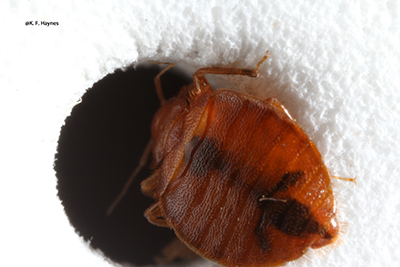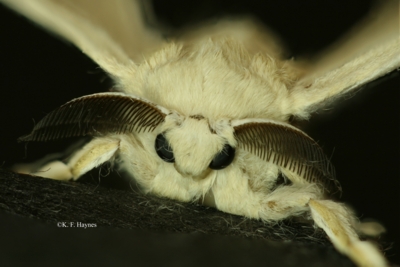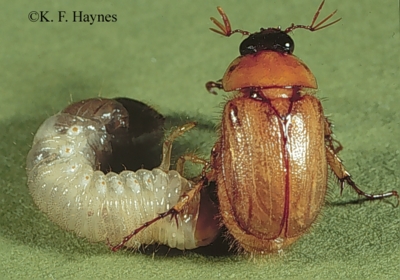Kenneth F. Haynes

Last Revised: Oct 11th, 2024
Professional Biography
Education
Ph.D. University of California, Davis (1982)
Research Program
My research program focuses on questions about insect behavior and chemical ecology. The diversity of insect behaviors mirrors the tremendous diversity of this group of animals. Many facets of these behaviors are mediated by chemical cues from the environment or signals produced by the insects themselves. We have only begun to scratch the surface in understanding the physiological and evolutionary underpinnings of a few of these behaviors. Our research group has explored the use of sex pheromones by moths, the exploitation of chemical communication by predators, the origins of signaling in beetles, and most recently the biology and behavior of the bed bug.
Biology and behavior of bed bugs
Despite their proclivity to hide near to where we sleep and stealthily feed on our blood, bed bugs are extremely fascinating insects. An understanding of their biology and behavior may provide clues to how to manage this now common urban pest. We are studying questions ranging from pheromone signaling to behavioral and physiological issues related to pest management. If you are not intrigued yet by bed bugs take a look at these two videos.

Speciation and the evolution of sex pheromone blends
Sex pheromones are nearly ubiquitous in moths, with females producing a blend of chemical compounds that are detected by males of the same species. Typically males will only respond to the specific blend emitted by the female. We study questions about how the signal and response have coevolved.

Aggressive chemical mimicry of prey pheromones
Evolutionary specialization of a predator on a few prey species has potential advantages and disadvantages. Such a predator can evolve to become highly efficient at finding, handling, and utilizing its prey, but the predator becomes dependent on availability of these particular prey, which could be costly in years of prey scarcity. The bolas spider Mastophora hutchinsoni is an extremely specialized predator. The adult female emits chemical attractants that mimic the sex pheromones of its moth prey, a form of aggressive chemical mimicry. This work involves a collaboration with Dr. Kenneth V. Yeargan.

Origins of chemical communication
It is apparent that chemical communication has originated many times. The female southern masked chafer, Cyclocephala lurida, releases a sex pheromone that attracts conspecific males. The presence of the same chemicals in the larval stage of this insect suggests that pheromone signals may have originated from larval odors. This work has been a long-time collaboration with Dr. Dan Potter.

Graduate Students and their Projects
Current Students
- Paul Baker, Ph.D. in progress. Aggregation and Host-finding in Bed Bugs.
Past Students
- Kathy McLellan (M.S., 1989) Chemical communication and reproductive isolation in two types of the fall webworm
- Debbie Campero (M.S.,1990) Sublethal effects of insecticides on chemical communication, courtship and oviposition in the cabbage looper moth
- Abdul Latif (Ph.D., 1992) Semio-chemical control of the behavioral responses of adult Dacus cucurbitae and D. zonatus
- Jing Zhao (M.S., 1994) Impact of head extracts and PBAN on chemical communication in the cabbage looper moth
- Cesar Gemeno (Ph.D., 1997) Chemical communication in the black cutworm
- Dan Hemman (M.S., 2000). Evolution of behavioral response to a mutant sex pheromone blend in the cabbage looper moth
- Bryan Spohn (Ph.D., 2000) Factors influencing the evolution of pheromone communication in the cabbage looper
- Charlene Rucker (M.S., 2003). Factors affecting pheromone blend discrimination and mating success in the cabbage looper
- Rebekah Hassell (M.S., 2009) The influence of heat and carbon dioxide on the host finding behavior of the bed bug
- Alvaro Romero (Ph.D. 2009) Biology and management of the bed bug
- Jennifer Gordon (Ph.D., 2014) Insecticide resistance in the bed bug
- Sydney Crawley (Ph.D., 2016) Chemical ecology of bed bugs
- Mark Goodman (Ph.D., 2016) Endosymbionts in bed bugs
Past Post-doctoral Scholars
- Dr. Randy Hunt (1987-89). Now Professor, Indiana University Southeast
- Dr. Yong Biao Liu (1991-94). Now with USDA-ARS
- Dr. Junwei “Jerry” Zhu (1995-96). Now with USDA-ARS
- Dr. Maya Evenden (1998-2000). Now Professor, University of Alberta
- Dr. Cesar Gemeno (1998-2000). Now with University of Lleida
- Dr. John Sloggett (co-advised). Now with Maastricht University
- Dr. Yukie Kajita (co-advised). Now Research Assistant Professor, University of Tennessee
- Dr. Jeremy Allison (2008). Now with Canadian Forest Service
- Dr. Sarah Butler (2008) Now with Invasive Species Centre, Ontario, Canada
- Dr. Jennifer R. Gordon (2015). Now with Clorox
- Dr. Katelyn A. (Kowles) Kesheimer (2015 -16). Now Assistant Professor and Extension Specialist at Auburn
- Dr. Sydney E. Crawley (2017). Now with Scotts Miracle-Gro
- Dr. Kacie Athey (2017-2018). Now Postdoctoral Scholar, Washington State University
